Coronavirus Today: Welcome to a new era
Good evening. I’m Karen Kaplan, and it’s Friday, March 4. Here’s the latest on what’s happening with the coronavirus in California and beyond.
Congratulations, Los Angeles County! In just a week, we went from the the highest tier in the federal government’s new COVID-19 risk-assessment system to its lowest.
To reward us for our progress, the county Department of Public Health has revised its health order to say that it no longer requires anyone to wear a mask indoors in places such as restaurants, offices, stores, gyms and movie theaters.
Vaccination verification rules have also been relaxed. Starting today, the county will not require anyone to show proof of vaccination or a negative COVID-19 test to grab a beer at a pub, visit a theme park or attend an outdoor mega-event such as a concert or professional soccer game.
As of Friday afternoon, L.A. County was reporting 111 weekly coronavirus cases per 100,000 residents, according to the U.S. Centers for Disease Control and Prevention. Last week, that figure was 216.
And we’re not the only Southern California county with a “low” coronavirus community level. Joining L.A. are Orange, San Diego, Riverside, San Bernardino, Ventura, Santa Barbara and San Luis Obispo counties. And with the exception of Santa Cruz County, which is in the “medium” tier, the entire coast from San Diego to Sonoma County is classified as “low.”
Altogether, 73% of Californians live in counties where levels are deemed low, and another 22% are in medium counties. Just 5% of residents are in counties in the “high” tier, a list that includes Kern, Tulare, Kings and Madera counties.
The dawn of L.A. County’s mask-optional era was greeted with a mixture of apprehension and joy.
In Koreatown, stylist Grace Lee at VIP Hair Salon said most customers there still preferred to keep their masks on. She’s not yet ready to take hers off either.
“I have to get Botox!” she said.
A few miles away in Larchmont Village, Madison Howell was happy to ditch her mask.
“It was just really nice to walk inside a store and not put anything on for the first time in two years,” she said outside a juice shop. “Today, I’m happier.”
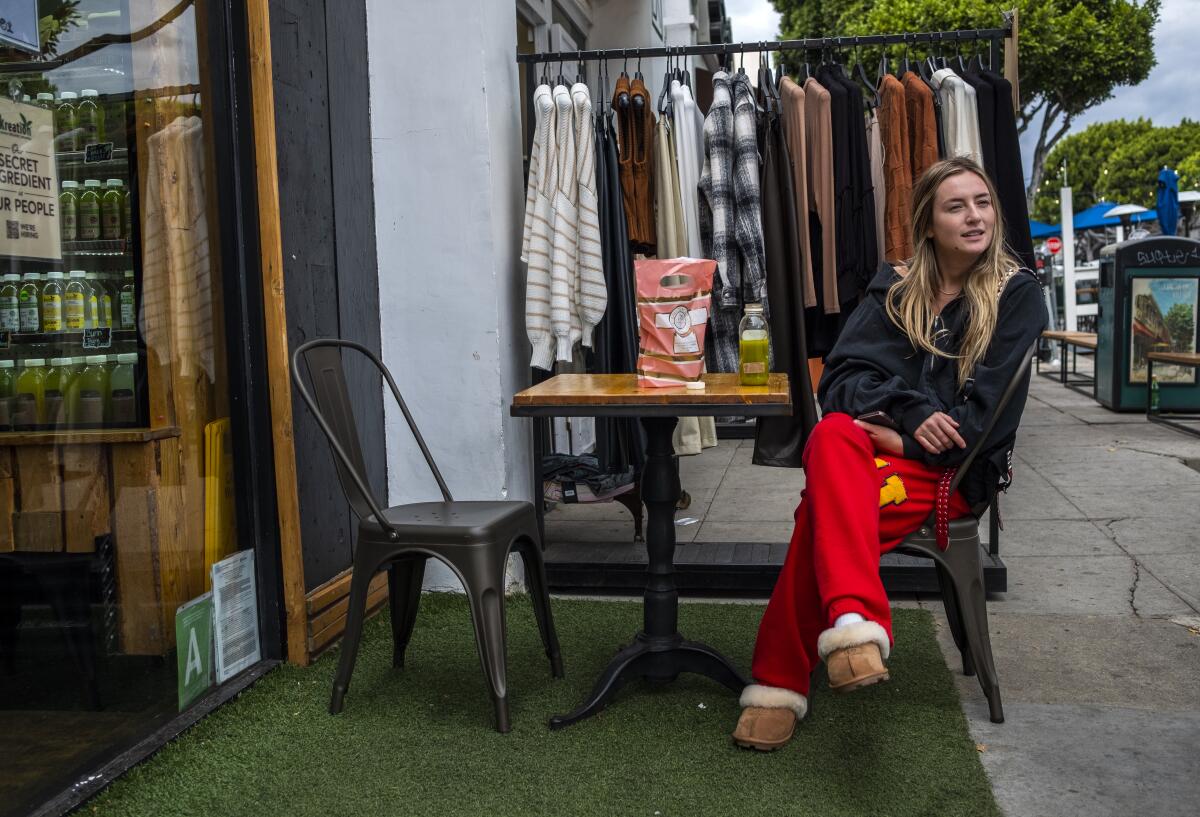
It certainly feels like something to celebrate. And the increase in mask-free faces we’re likely to start seeing is a sure sign that we’ve turned a corner in the pandemic.
Here’s another: This is the last Friday edition of Coronavirus Today. Starting next week, we’ll be coming to you once a week on Tuesdays.
But the more things change, the more they stay the same.
Two years into the outbreak, wealth, poverty and race still dramatically affect the toll the coronavirus takes, my colleagues Rong-Gong Lin II and Luke Money remind us. Even though the Omicron variant behaves differently than the original SARS-CoV-2 virus, L.A. County’s Latino and Black communities continue to take significantly harder hits than wealthier white ones.
In the two-week period ending Feb. 11, 74 out of every 100,000 unvaccinated Latino residents were hospitalized for COVID-19, as were 60 out of every 100,000 unvaccinated Black residents. Yet among unvaccinated white residents, 43 per 100,000 were hospitalized with the disease, along with 30 of every 100,000 unvaccinated Asian Americans.
The disparities weren’t limited to the unvaccinated. Although the hospitalization rates were much lower, the gap remained: For every 100,000 vaccinated and boosted residents in each racial or ethnic group, 13 Latino, 11 Black, five white and three Asian American people were admitted to hospitals for COVID-19.
Barbara Ferrer, the county’s public health director, said Black and Latino residents were more likely to be exposed to the coronavirus at work or at home, and they’re also more likely to have preexisting health conditions that make them more vulnerable when that happens. If the outbreak rebounds after mask mandates ease, these are the people who will suffer the most.
“These data on hospitalizations and deaths are alarming,” Ferrer told the Board of Supervisors this week. “We have to ensure that our post-surge actions do not widen the gaps.”
Dr. Elaine Batchlor, the chief executive of Martin Luther King Jr. Community Hospital in Willowbrook, is worried that they will.
“Communities like South L.A. that have been hit hard and disproportionately affected by COVID remain at higher risk,” she told my colleague Erika D. Smith.
The solution isn’t simply to keep wearing masks, Batchlor said, but to eliminate the underlying disparities in healthcare access. The way she sees it, the neighborhoods around her hospital need an additional 1,300 doctors to serve the hundreds of thousands of people who live there.
“Our vision is to create an integrated healthcare system that provides affordable, accessible, high-quality healthcare to people who live in South L.A.,” she explained.
The money to make this happen could come from Sacramento in the form of Assembly Bill 2426. Not only would it increase funding for the hospital, but it would also make it easier for Batchlor and her staff to spend that money on prevention and disease management.
That said, masks will still help keep people healthy, said Dr. Mark Ghaly, the state’s health and human services secretary. He is strongly recommending that Californians continue to wear masks indoors to protect the vulnerable among us until case rates drop further.
That list includes children under 5 who are still too young to be vaccinated, as well as people at risk of becoming seriously ill if they catch COVID-19, such as those who are older, immunocompromised, or suffering from conditions like asthma, diabetes or heart disease.
And if you want to know what’s in it for you, wearing a mask will reduce your chance of infection, which in turn will reduce your risk of developing “long COVID,” a still-mysterious condition that can affect even those who have mild cases of COVID-19.
Just ask Sen. Tim Kaine (D-Va.). He had a mild case of COVID-19 with flu-like symptoms way back in March 2020. Two years later, he’s still dealing with a constant nerve-tingling that doctors are helpless to improve. (He and two Senate colleagues introduced legislation this week to provide more resources to patients like him.)
“I tell people it feels like all my nerves have had like five cups of coffee,” Kaine told the Washington Post.
By the numbers
California cases and deaths as of 5:40 p.m. Friday:

Track California’s coronavirus spread and vaccination efforts — including the latest numbers and how they break down — with our graphics.
A woman’s work ...
Someday, the pandemic will be truly over. But that doesn’t guarantee things will go back to the way they were before. A new study published this week raises concerns that, from an economic and social standpoint, women will not recover to the same extent as men.
The researchers culled data from more than a dozen sources to learn how the pandemic had affected men and women in 193 countries. Some of that information was directly related to COVID-19, such as vaccination rates. Some of it was about health in general, such as whether access to medication or routine care has been cut off during the outbreak. And some of it was about education, such as the availability of distance learning when schools were forced to close their doors.
But the researchers didn’t stop there. The team, led by Luisa S. Flor and Joseph Friedman of the University of Washington’s Institute for Health Metrics and Evaluation, also examined the extent to which workers lost jobs and income, as well as changes in workloads at home.
In both cases, they found striking differences based on gender.
Let’s start with employment. Although many millions of people lost work in the initial months of the pandemic, the global job picture improved by the end of 2020, then improved some more during the summer of 2021. But at every time point, women were more likely than men to be unemployed, and that gender gap held up in every region of the world. By September 2021, 26% of women said they had lost work during the pandemic, along with 20.4% of men.
Loss of income was even more prevalent, with 58.4% of people surveyed saying they’d taken a hit during the pandemic. But unlike with unemployment, income loss was equally likely to affect men and women in most parts of the world.
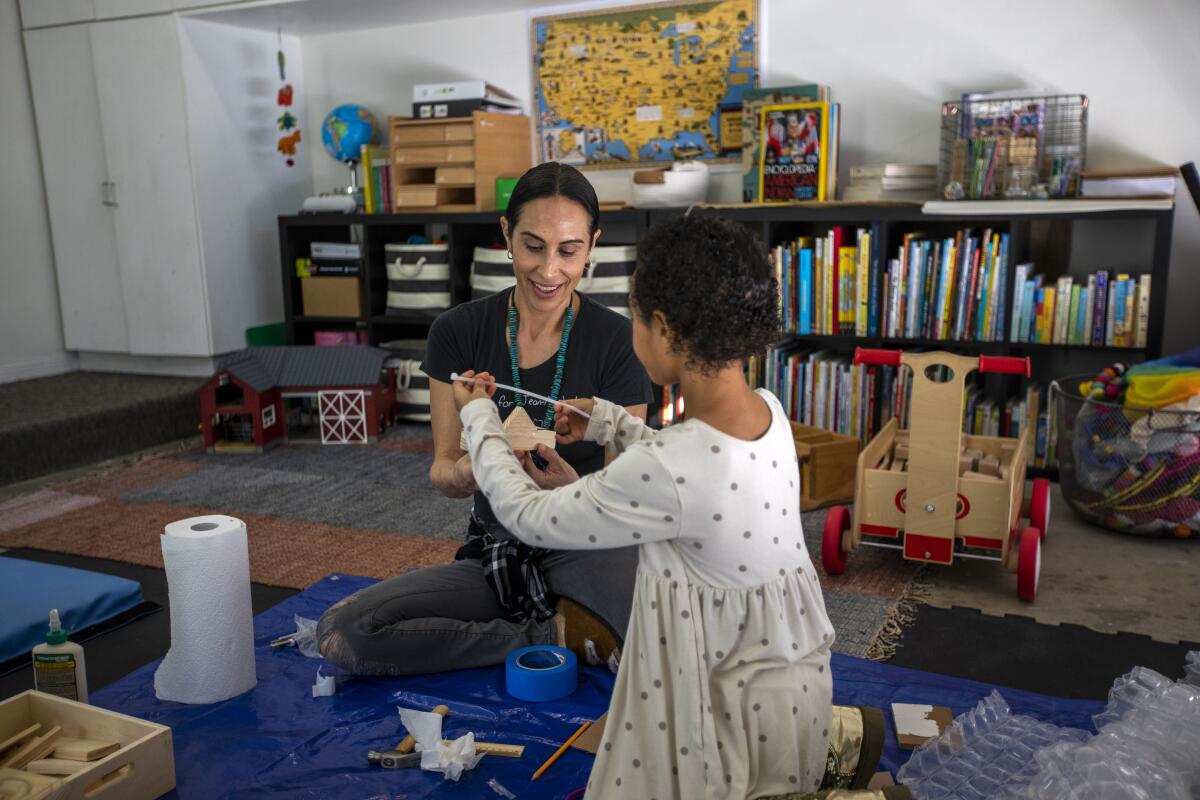
People may have been earning less, but they weren’t working less. More than half of those asked about their home lives said they spent more time doing chores and caring for others than they did in their pre-pandemic lives.
In every region, the proportion of women who took on more chores was higher than the proportion of men. The gender gap was smallest in Southeast Asia, East Asia and Oceania, and it was largest in North Africa and the Middle East, followed closely by Latin America and the Caribbean. In high-income countries, 37.4% of men reported spending more time on chores, compared with 43.6% of women.
Chores weren’t the only thing keeping women busy at home. All over the world, women were more likely than men to say they’d scaled back or quit their jobs to care for others. The gender gaps were smaller than for chores, but they were pervasive — the researchers found them in 77 of the 107 countries for which data were available.
Not only that, the gender gap widened over time. In the early days of the pandemic, women were 1.8 times more likely than men to say they’d missed out on work to care for someone else; by September 2021, they were 2.4 times more likely to report having done so.
“Women were disproportionately affected by the economic fallout of the pandemic,” the researchers wrote in the medical journal Lancet.
“Without purposeful policy action to boost gender parity, reduced participation of women in the workforce is likely to persist in the future,” they added. “The importance of changing long-standing widespread attitudes about the role of women in society cannot be overstated.”
The team noted some limitations of their findings, including the fact that most of the surveys they drew from were administered online or via smartphone apps. Since access to digital technology isn’t universal, the participants aren’t a representative sample of the global population as a whole. Also, although the changes they observed occurred after the onset of the pandemic, the researchers can’t be certain they were caused by the pandemic.
Despite these caveats, the findings demand action, according to a commentary that accompanies the study.
“Increasingly there is concern that the inequities exacerbated by the pandemic are only going to worsen, and that any progress towards gender equality made before the pandemic will be reversed,” wrote a trio of researchers who study gender and health. “Hopefully these data will reinforce the need for decision makers to act before it is too late.”
California’s vaccination progress
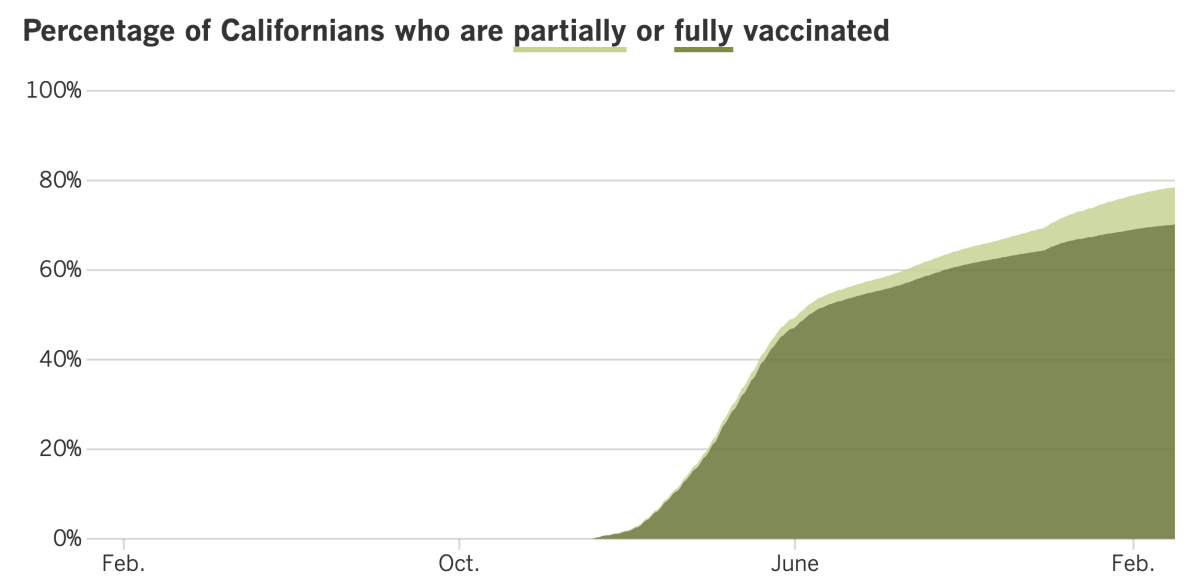
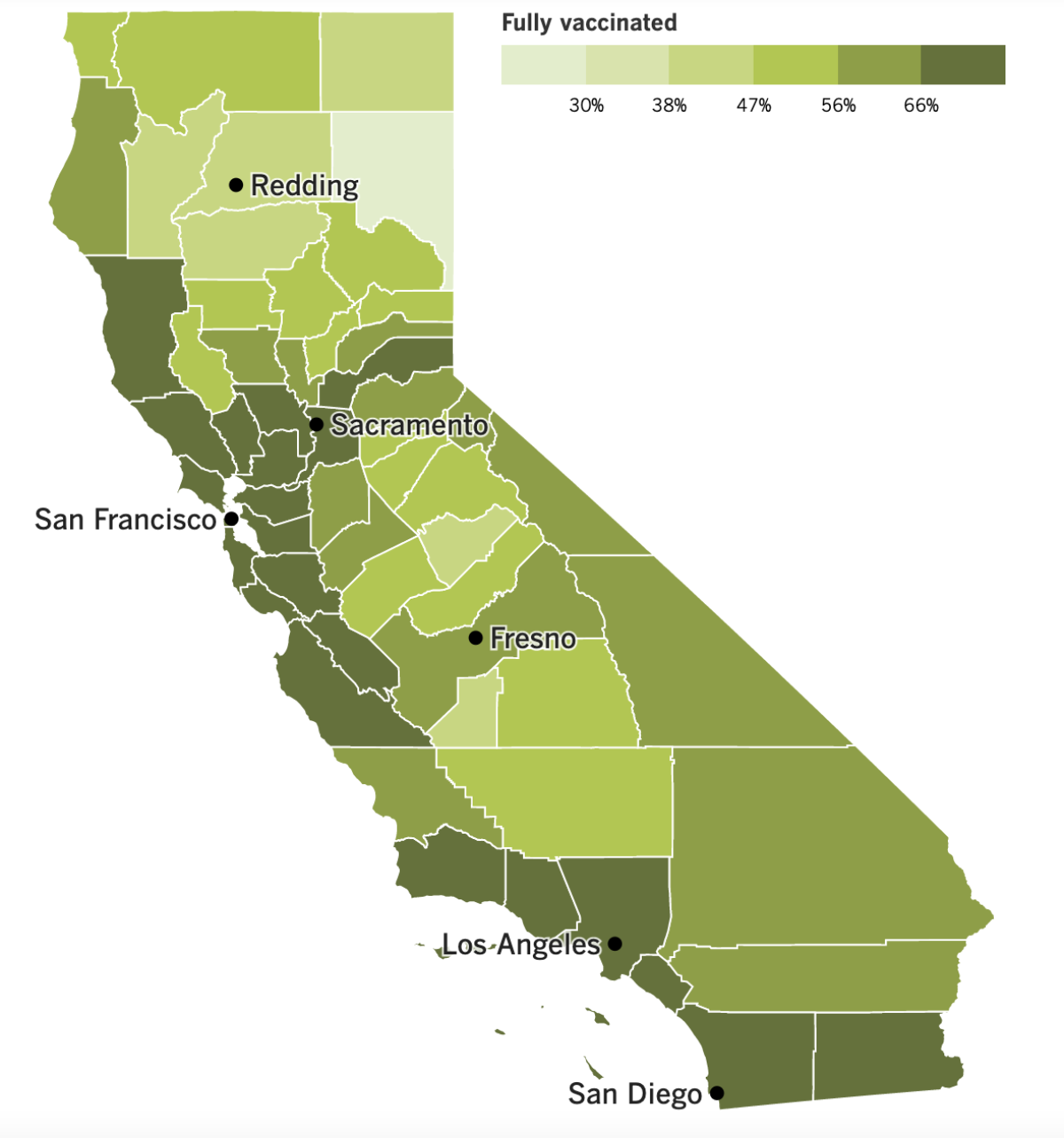
See the latest on California’s vaccination progress with our tracker.
Your support helps us deliver the news that matters most.
In other news ...
The World Health Organization has issued another encouraging COVID-19 report card. It says the number of new coronavirus cases around the world fell 16% last week, and that deaths were down 10%. Even so, about 60,000 people died of COVID-19 last week, and more than 10 million became infected.
Worldwide infections have been falling for a month, and deaths have declined for two weeks. The only region to buck the trend was the Western Pacific, which includes China, Japan, Australia, New Zealand and more than 30 other countries. Infections in that region increased by one-third over the previous week, and deaths rose 22%. In the Americas, which includes the entire Western Hemisphere, deaths fell 8% compared to the prior week.
Remember when we wondered whether Omicron could out-compete Delta? The answer is a resounding YES. Among the nearly 500,000 coronavirus samples whose genomes were shared with GISAID over the past 30 days, a little more than 99.5% were Omicron, and only 0.3% were Delta.
With cases and deaths dropping, President Biden has laid out a new approach to dealing with COVID-19. He envisions a scenario in which Americans can drop into their local pharmacy to take a coronavirus test, and if the result is positive, they’ll get antiviral pills for free right then and there.
The “test to treat” initiative was introduced during the State of the Union address. It’s part of a 96-page plan that includes ways to fight COVID-19 both here and abroad, prepare for the emergence of new coronavirus variants, and avoid the disruptive shutdowns that many Americans are fed up with. In short, the plan is meant to ensure that the virus no longer dictates how we live.
One thing’s for sure: Americans who want COVID-19 vaccines won’t have to worry about shortages. In fact, demand has sunk so low that many states are scrambling to use up their vaccine stockpiles before they go to waste.
Millions of doses have already been squandered here. Sometimes a multi-dose vial was opened to administer a single shot and there were no takers for the remaining vaccine. Sometimes doses expired before the vials were even opened.
To prevent even more waste, public health officials are trying to shuffle the vaccine to providers who can use it. But they can’t just send it to other countries with lower vaccination rates. The doses must remain cold, so the logistics of transporting them overseas aren’t as simple as it might seem. Nor is it cost-effective to round them up when they’re scattered all over the country.
Between 550 million and 600 million doses have been administered in the U.S., according to the Department of Health and Human Services. California has received 84 million doses and wasted about 1.4 million of them. That’s a big number but a relatively small percentage. For the sake of comparison, Michigan has wasted nearly 1.5 million doses, North Carolina 1.45 million and Illinois 1 million.
Only about 70,000 Americans are getting their first shot each day. That’s the lowest figure since the vaccination campaign kicked off in December 2020. About 30% of Americans who are old enough to get a shot still aren’t fully vaccinated, according to the CDC.
Speaking of vaccines, regulators in Europe have authorized Moderna’s COVID-19 vaccine for children ages 6 to 11. The European Medicines Agency had already approved the Moderna vaccine for 12- to 17-year-olds, and the doses for younger children will be half the size of the ones given to adults and teens. Studies in school-age children have shown that the smaller dose prompts an immune response that’s comparable to that seen in older people who get the full dose.
The EMA also authorized booster shots of the Pfizer-BioNTech vaccine for adolescents 12 and older.
And finally, police in New Zealand have managed to accomplish what Barry Manilow recordings could not: They’ve broken up the weeks-long protest against COVID-19 vaccine mandates in the capital city of Wellington.
The operation began at dawn, with officers warning hundreds of demonstrators camped out on the Parliament grounds that they were trespassing and needed to leave. Then police tore down tents around the periphery before moving in with pepper spray. Some of the 300 or so cars, trucks and vans used to block streets were towed away.
Not all of the protesters left willingly. They set fire to tents, mattresses and chairs, and some hurled objects at officers. (At least it wasn’t feces, like last week.) Sixty-five people were arrested on suspicion of trespassing, causing damage and carrying weapons.
“I was both angry and also deeply saddened to see the Parliament — your Parliament, our Parliament — desecrated in that way,” said Prime Minister Jacinda Ardern. “But as I say, it’s not something that will define New Zealand’s response to this pandemic.”
Your questions answered
Today’s question comes from readers who want to know: Where do I still need to wear a mask in Los Angeles County?
Good question! With all the excitement about the county rescinding its indoor mask mandate, you might be left with the impression that masks are now optional everywhere. We’ve made a lot of progress, but we’re not quite there yet.
Your mask is still needed at:
- Any business that chooses to require them for both customers and employees.
- Indoors at K-12 schools and childcare centers, at least through March 11. (After that, school districts and childcare providers can decide whether to keep mask rules in place or make face coverings optional.)
- On planes, buses and other forms of public transportation, under an order from the CDC.
- In hospitals, nursing homes and other healthcare settings, according to rules from the California Department of Public Health.
- In homeless shelters, emergency shelters and correctional facilities, also per state rules.
- In any public setting — indoors or outdoors — if you have an active coronavirus infection. You’ll need to keep wearing a mask for 10 days after you test positive or you experience your first COVID-19 symptoms.
Of course, you can opt to wear a mask even if it’s not required. Both the county and the state strongly recommend that you do so when you’re in an indoor public space.
We want to hear from you. Email us your coronavirus questions, and we’ll do our best to answer them. Wondering if your question’s already been answered? Check out our archive here.
The pandemic in pictures
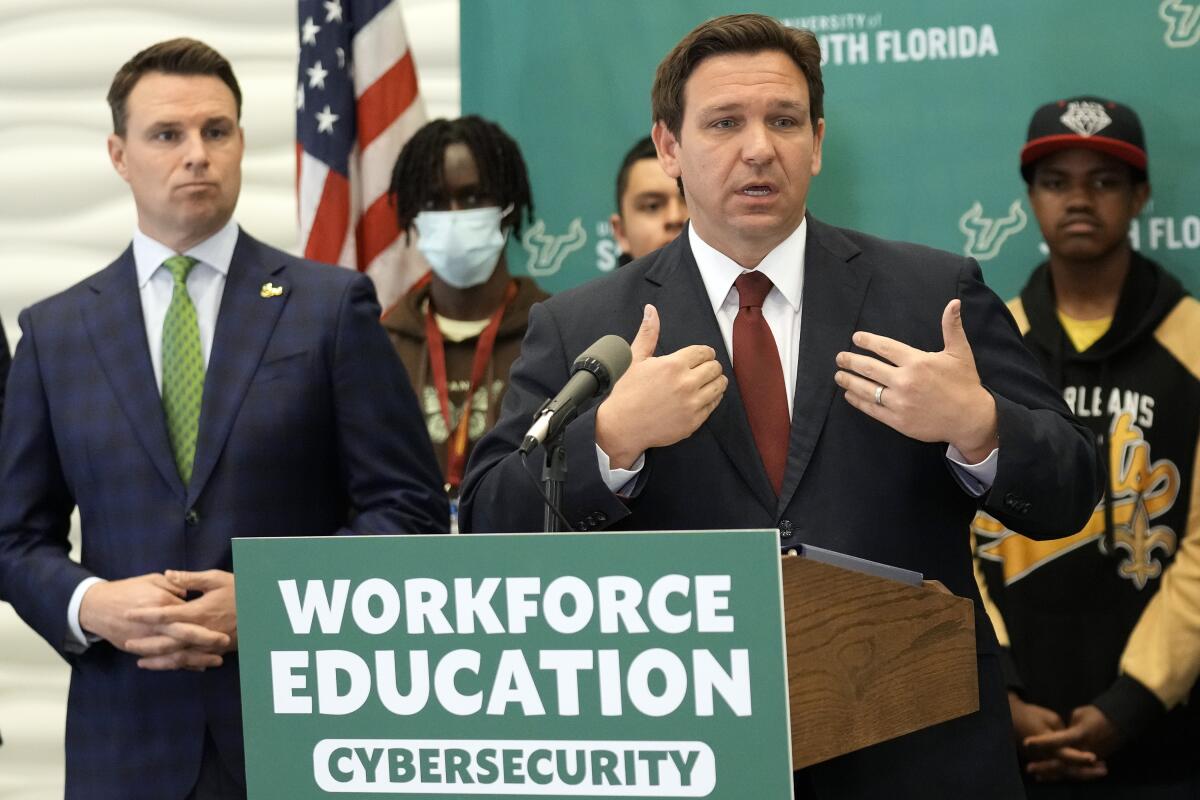
The man at the podium in the photo above is Florida Gov. Ron DeSantis. He’s speaking during a news conference to announce a new cybersecurity education initiative at the University of South Florida in Tampa.
That announcement was overshadowed by other words aimed at some of the high school students invited to the event.
“You do not have to wear those masks,” DeSantis said, shaking his head. “I mean, please take them off. Honestly, it’s not doing anything. We’ve got to stop with this COVID theater. So if you want to wear it, fine, but this is ridiculous.”
The governor punctuated his admonition with an audible sigh.
One of the masked students in attendance was 14-year-old Kevin Brown Jr., a high school freshman. He said he was caught off-guard and felt pressured to remove his mask. He left it on anyway — you can see him standing next to the flag in the photo, before he was pulled off the stage — since he was wary of catching the coronavirus in a room full of unmasked people in a county that, according to the CDC, still has a high rate of transmission.
“Everyone in Hillsborough County, Florida should wear a mask in public, indoor settings,” the agency advises.
DeSantis may not have been happy with the teen’s decision, but his father certainly was.
“I tell him it’s his choice, so he made that choice and the governor has no right to tell no kid or no one who they can or can’t wear a mask. He doesn’t have that right,” Kevin Brown Sr. told Tampa’s WFLA-TV.
The elder Brown also had some advice for DeSantis: “Stop bullying kids.”
Resources
Need a vaccine? Here’s where to go: City of Los Angeles | Los Angeles County | Kern County | Orange County | Riverside County | San Bernardino County | San Diego County | San Luis Obispo County | Santa Barbara County | Ventura County
Practice social distancing using these tips, and wear a mask or two.
Watch for symptoms such as fever, cough, shortness of breath, chills, shaking with chills, muscle pain, headache, sore throat and loss of taste or smell. Here’s what to look for and when.
Need to get a test? Testing in California is free, and you can find a site online or call (833) 422-4255.
Americans are hurting in various ways. We have advice for helping kids cope, as well as resources for people experiencing domestic abuse.
We’ve answered hundreds of readers’ questions. Explore them in our archive here.
For our most up-to-date coverage, visit our homepage and our Health section, get our breaking news alerts, and follow us on Twitter and Instagram.




